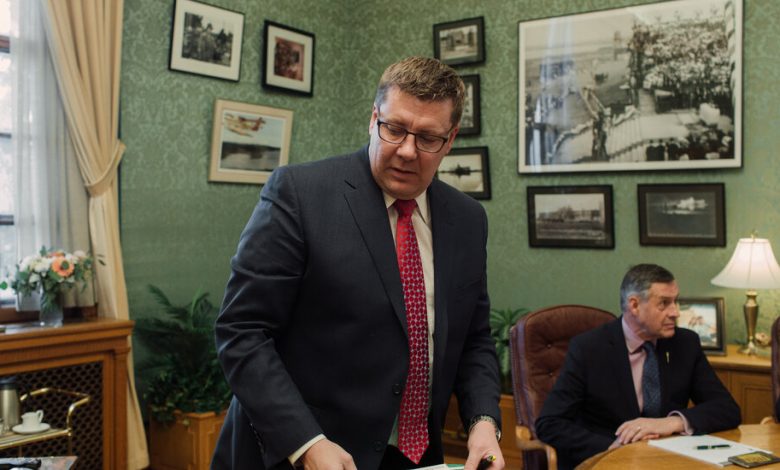The Unique Ability of Canadian Governments to Set Aside Rights

In June, the Canada Letter looked at the decision by Blaine Higgs, the premier of New Brunswick, to roll back a policy that required teachers to use the preferred names and genders of schoolchildren. His new plan, which requires teachers to get the permission of a child’s parents if the child is under the age of 16, set off a firestorm that included the resignations of members of his cabinet.

Premier Scott Moe of Saskatchewan has moved to shield a gender identity law from the courts.Credit…Amber Bracken for The New York Times
Now the issue has surfaced again in Saskatchewan. Following the lead of Mr. Higgs, Premier Scott Moe recalled his province’s legislature early this week to introduce a bill that, if passed, will mandate parents’ consent for a number of things including allowing pupil’s teachers and school employees to use the “pupil’s new gender-related preferred name or gender identity at school” for anyone under 16.
The debate for and against the policy mirrors the earlier discussion in New Brunswick, so I won’t go over it again this week, but I will look instead at another significant step taken by Mr. Moe.
The premier pre-emptively overruled any court decision declaring the law unconstitutional, by invoking the lugubriously named “notwithstanding clause” of the Charter of Rights and Freedoms. The Department of Justice has an excellent primer about the clause. It is unique among the constitutions of democratic countries and gives federal and provincial governments the ability to ignore most of the constitutional rights of Canadians other than the right to vote, the seating of legislatures and the House of Commons, mobility rights and language rights. No explanation for the move is required.
This power to set aside rights was part of a political compromise that resulted in Canada’s finally getting an agreement, among all the provinces except Quebec, that created the constitution in 1982. For much of its history, it was rarely used other than by Quebec (the federal government has never invoked it) and was regarded as an option of last resort.
As more premiers turn to it, legal scholars are increasingly concerned that the stigma against use of the clause is fast fading. And they are particularly worried about a growing number of premiers who, like Mr. Moe, simply assume that their laws are unconstitutional and invoke the clause before any court can review them.
“This is a very dangerous trend,” Nathalie Des Rosiers, the principal at Massey College at the University of Toronto, told me. “The fear is that the protection of civil rights and political rights is made more vulnerable by a repeated, normalized use of the notwithstanding clause. It almost makes the charter implode on itself.”
While bills in the legislature would not normally be used to set school policies, Dwight Newman, a professor of constitutional law at the University of Saskatchewan, told me that by making it law, Mr. Moe’s government will also shield its plan from challenges under the Saskatchewan Human Rights Code.
Mr. Moe’s rush to legislation was prompted by a judge’s decision that was released at the end of September. The court placed a temporary injunction on executing the new policy until it could hear a constitutional challenge brought by the UR Pride Centre for Sexuality and Gender Diversity, a L.G.B.T.Q. rights and support group based in Regina.
In his decision, Justice M.T. Megaw of the Court of King’s Bench for Saskatchewan noted that the province had not filed an explanation of why it undertook the change and whom, if anyone, it had consulted before making it, nor had it offered any argument about its constitutionality.
“It surprises me a little bit that the province didn’t present more of a legal argument,” Dr. Newman told me. “What is this issue? Obviously, people are going to have some pretty strong views about the issue and about the use of the notwithstanding clause.”
An affidavit from an official in the provincial ministry of education, provided to the court, appears to show that the policy change was prompted by 18 letters from people suggesting that Saskatchewan introduce the same rules as New Brunswick. The judge noted that it was unclear how many of those people, if any, lived in Saskatchewan.
Professor Des Rosiers, who is the former head of the Canadian Civil Liberties Association, said that some cases now in the courts might ultimately end the ability of premiers and prime ministers to pre-emptively set the constitution aside. She noted as well that last year a court loss and widespread criticism had prompted Premier Doug Ford of Ontario to abandon his plan to invoke it to take the right to strike from teachers.
A former Ontario cabinet minister in a Liberal government, Ms. Des Rosiers said that she thought the growing interest of some premiers in setting aside rights by using the clause was perhaps more related to politics than to specific issues.
“They use the notwithstanding clause to feed their base the idea that we’ve gone too far in human rights and that the courts have been leading us in the wrong way — let’s capture back the power of the elected,” she said. “It’s a little bit of wedge politics.”
Trans Canada
-
My colleague Norimitsu Onishi has looked into how a push to “decolonize” museums has rocked the National Gallery of Canada and other institutions.
-
Danial Adkison, an editor in the Travel desk of The Times, offers his suggestions for visiting Montreal in the popular 36 Hours feature.
-
Claude Cormier, the landscape architect from Montreal who enlivened Toronto as well as his hometown with humorous designs for parks and other public spaces, has died at the age of 63.
-
Watching, The Times viewing guide, recommends “Little Bird,” a dramatic series built around the lawsuit over forced adoptions, known as the Sixties Scoop, led by a creative team of Indigenous women. Canadian viewers can also watch it on Crave and APTN Lumi.
-
After a brief strike by 4,000 workers, Unifor reached a tentative agreement with General Motors Canada. It follows an earlier deal with Ford, leaving only workers at Stellantis without a new contract.
A native of Windsor, Ontario, Ian Austen was educated in Toronto, lives in Ottawa and has reported about Canada for The New York Times for more than two decades.
How are we doing?
We’re eager to have your thoughts about this newsletter and events in Canada in general. Please send them to [email protected].
Like this email?
Forward it to your friends, and let them know they can sign up here.




